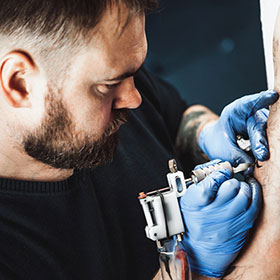Do above the knee tattoos hurt? Yes, they can.
The pain level varies for each person. Tattoos above the knee can be both exciting and nerve-wracking. The skin around this area is less padded, making it more sensitive. Pain tolerance differs from one individual to another, so what feels unbearable to one might be just a slight discomfort to another.
This guide will help you understand what to expect when getting a tattoo above the knee. We’ll explore factors that influence pain, tips for managing discomfort, and what to consider before getting inked in this area. Read on to prepare yourself and make an informed decision about your next tattoo adventure.
Introduction To Above The Knee Tattoos
Tattoos above the knee are becoming more popular. People love to show off their legs. This tattoo spot is easy to hide or show. It makes it a great choice for many.
The skin above the knee is less sensitive. This area can handle the pain better. It also allows for larger designs. You can get creative with your tattoo here.
Many people choose bold designs. Flowers, animals, and patterns are popular. Some go for tribal or geometric shapes. Others like to add words or quotes. The options are endless.
Pain Factors
Skin above the knee can be very sensitive. This area has many nerve endings. Tattoos in this spot can feel more painful. Thin skin might make it worse. Some people find it hard to handle.
Areas with less fat feel more pain. Above the knee has less cushion. This means more discomfort. Muscles here can also make it tougher. Strong muscles might tense up during a tattoo. It can add to the pain.
Tattoo Placement
The inner thigh is a soft area. This part of the body has many nerve endings. Tattooing here can be more painful. The skin is thin. There is less muscle. This means you feel the needle more. Some people find it very uncomfortable. Pain levels vary from person to person. Some describe it as a sharp pinch. Others feel a burning sensation. It is important to prepare mentally. Take breaks if needed.
The outer thigh is a popular spot for tattoos. This area has more muscle and fat. Pain is usually less here. The needle does not reach the bone easily. Many find this area more tolerable. The skin is thicker. Tattooing here can still hurt, but it is often less intense. You may feel a dull ache. Some describe it as a vibration. Everyone has a different pain threshold. It is good to stay relaxed.
Pain Management Techniques
Topical anesthetics can help. These creams numb the skin. Apply them before the tattoo session. This reduces the pain. Follow the instructions on the package. It is important. Ask your tattoo artist for recommendations. They know the best products.
Breathing exercises are useful. Take deep breaths. Breathe in slowly. Then breathe out slowly. This helps to stay calm. It also reduces pain. Focus on your breathing. It distracts from the pain. Practice before your tattoo session. It will make a difference.
Artist’s Skill Level
A skilled artist can make a big difference. They know how to work with the skin. Their technique can reduce pain. A good artist uses the right tools. They also make sure you feel comfortable.
Experience matters in tattooing. An experienced artist has done many tattoos. They know how to handle the needle. They understand different skin types. This helps in reducing pain. They also work faster and more efficiently.
Aftercare Tips
Keep your tattoo moist. Dry skin can cause itching. Use a gentle, fragrance-free lotion. This helps your skin heal. Apply the lotion twice a day. Always wash your hands first. This avoids germs getting on your tattoo. Never overdo it. Too much lotion can clog pores. This might slow healing.
Keep your tattoo clean. Wash it with mild soap and water. Pat it dry with a clean towel. Never rub. Rubbing can irritate the skin. Wear loose clothing over your tattoo. Tight clothes can trap bacteria. This can cause infection. Avoid swimming in pools or lakes. Water can carry germs. Stay safe. Keep your tattoo clean and dry.
Personal Pain Threshold
Everyone feels pain differently. Some people have a high pain tolerance. Others feel more pain in sensitive areas. The skin above the knee is thin. This can make the area more painful for tattoos. Nerves are close to the surface here. Take this into account before deciding.
Talk to a tattoo artist. They have experience with different pain levels. They can give advice based on your pain tolerance. Professional guidance helps in understanding what to expect. It is important to ask questions. Prepare yourself mentally for the tattoo process.
Real Experiences
Many people say tattoos above the knee hurt a lot. This area is quite sensitive. The skin is thin. The pain can be sharp.
Others find it more tolerable. Some even describe it as a tickle. It really depends on one’s pain threshold. Personal experience varies.
Above the knee tattoos are often more painful. In contrast, areas with more fat hurt less. The inner thigh can be very painful too. Bones make pain worse. The outer thigh is usually less painful.
Conclusion
Tattoos above the knee can be painful. Pain levels vary by person. Some feel mild discomfort. Others find it more intense. Consider your pain tolerance. Consult a tattoo artist. They offer helpful advice. Proper care reduces pain. Always follow aftercare instructions.
Choose a skilled artist. This ensures a better experience. Think about your decision carefully. Tattoos are a lasting commitment.

